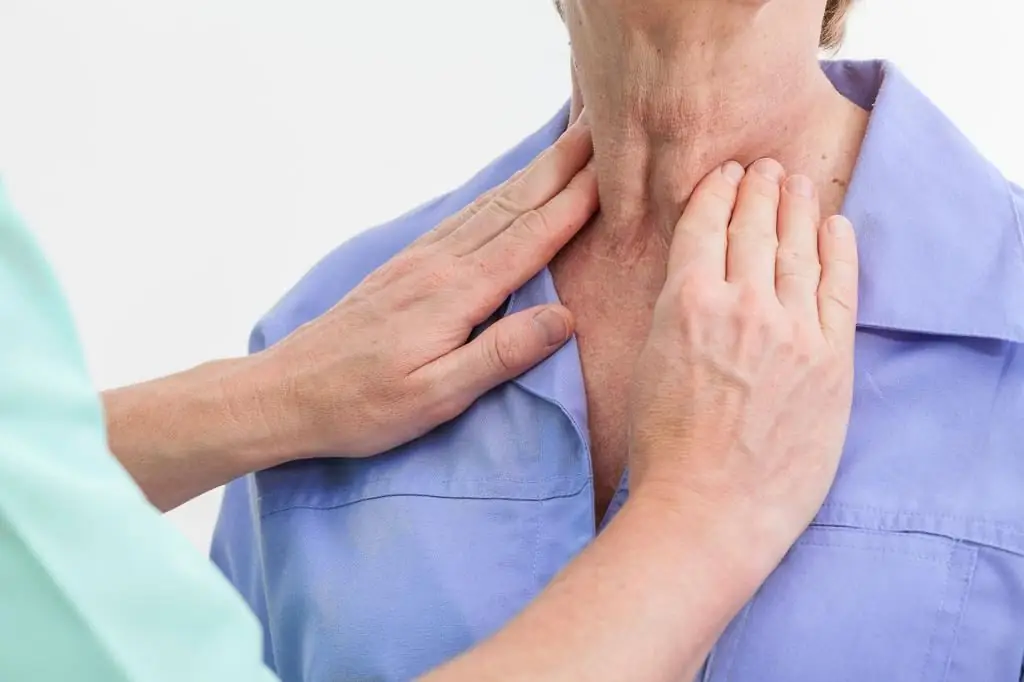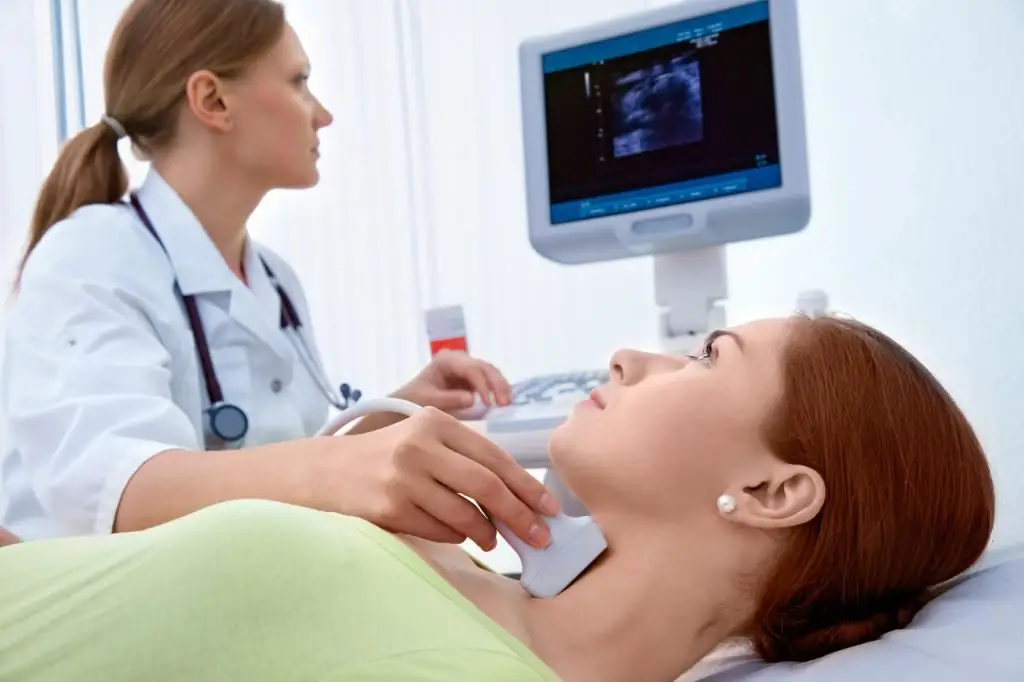- Author Curtis Blomfield [email protected].
- Public 2023-12-16 20:44.
- Last modified 2025-01-23 17:01.
Diffuse-nodular toxic goiter is a disease caused by hypertrophy and hyperfunction of the thyroid gland, which is accompanied by the development of thyrotoxicosis. This disease is manifested by increased excitability, and, in addition, irritability, heart palpitations, weight loss, shortness of breath and sweating. Bulging is a characteristic symptom. The disease leads to changes in the cardiovascular system, as well as to adrenal insufficiency. The main threat to the life of patients is the onset of a thyrotoxic crisis.

About pathology
Diffuse-nodular toxic goiter is characterized by an autoimmune nature and develops due to defects in the immune system, in which the production of antibodies to TSH receptors occurs, which have a constant stimulating effect on the thyroid gland. This leads to a uniform growth of thyroid tissues, hyperfunctions and an increase in the level of thyroid hormones: T3 and T4. An enlarged glandcalled a goiter.
An excess of thyroid hormones can increase basal metabolic reactions, significantly depleting the body's energy supply required for normal cellular life. The most susceptible to the state of thyrotoxicosis are the cardiac, vascular and nervous systems.
About the causes of pathology
Nodular toxic goiter can develop mainly in women aged 20-50. In the elderly, as in childhood, such a disease occurs quite rarely. Endocrinology cannot yet accurately answer the question of the cause and mechanism of triggering the autoimmune reaction underlying toxic diffuse goiter. This disease is sometimes detected in patients who have a hereditary predisposition, which is realized under the influence of many factors of the internal and external environment.
The appearance of nodular toxic goiter (ICD 10 E05.2) is promoted by infectious and inflammatory diseases along with mental trauma, organic brain damage (whether cranial trauma or encephalitis), autoimmune and endocrine disorders (we are talking about the functions of the pancreas, pituitary gland, gonads and adrenal glands) and many others. The risk of developing a goiter almost doubles when patients smoke.
Degrees of pathology and classification
Diffuse-nodular toxic goiter can be manifested by the following variations of thyrotoxicosis, regardless of the size of the thyroid gland:
- With a mild degree, the patient is dominated by complaints of a neurotic nature with the absence of cardiac arrhythmias. There may be complaintsfor tachycardia with a frequency of not more than one hundred beats per minute. There is no pathological dysfunction of other endocrine glands.
- In the second degree of diffuse-nodular toxic goiter, weight loss is noted within eight to ten kilograms per month. Severe tachycardia is also observed. Nodular toxic goiter of the 2nd degree is quite common.
- Severe degree is accompanied by weight loss to the limit of exhaustion, there are signs of a functional disorder in the kidneys, heart and liver. Usually this is observed when toxic goiter is not treated for a long time.

Next, we will find out in detail what symptoms accompany this endocrine pathology.
Symptomatics
What are the symptoms of nodular toxic goiter? Consider further.
Since thyroid hormones are responsible for performing various physiological functions, the appearance of thyrotoxicosis is accompanied by a variety of clinical manifestations. Usually, patients' complaints are directly related to cardiac and vascular changes, with symptoms of endocrine ophthalmopathy and catabolic syndrome. Cardiac and vascular disorders can be manifested by rapid, pronounced heartbeat, that is, tachycardia. The feeling of heartbeat in patients can occur in the chest, in the abdomen, in the hands. Heart beats at rest in the presence of thyrotoxicosis can increase up to 130 beats per minute. In the presence of moderate thyrotoxicosis, an increase in systolic and a decrease in diastolic pressure are observed along withincreasing pulsation.
Myocardial dystrophy
In the case of a prolonged course of thyrotoxicosis, especially in elderly patients, a bright and pronounced myocardial dystrophy develops. It can be manifested by disturbances in the heart rhythm, which will be expressed by atrial fibrillation and extrasystole. Subsequently, all this will lead to changes in the myocardium and to a congestive phenomenon. For example, peripheral edema, ascites, and cardiosclerosis may appear. There may be respiratory arrhythmia, as well as a tendency to frequent pneumonia.
The occurrence of catabolic syndrome is characterized by a sharp weight loss of about 15 kilograms against the background of a good appetite. General weakness and hyperhidrosis are not excluded. Violation of thermoregulation, as a rule, manifests itself in the fact that the patient experiences a feeling of heat and does not freeze at sufficiently low ambient temperatures. Elderly patients may experience evening subfebrile condition.

Symptomatics of the organs of vision
For diffuse nodular toxic goiter, the development of changes in the eyeballs is typical. In this case, we are talking about endocrine ophthalmopathy, against which the palpebral fissures expand due to the lifting of the upper eyelids and the lowering of the lower ones. Thus, incomplete closure of the eyelids is noted, combined with rare blinking, exophthalmos (bulging eyes) and eye glare. In a patient with this pathology, the face takes on an obvious expression of fear, anger and surprise.
Due to incomplete closure of the eyelids, such patients complain of the appearance of sand ineyes, dryness and chronic conjunctivitis. The development of edema and overgrowth of periorbital tissue compresses the eyeball and nerves, causing visual field defects along with increased intraocular pressure, eye pain, and sometimes complete loss of vision.
Symptoms of deviations in the activity of the nervous system
On the part of the functioning of the nervous system in the presence of thyrotoxicosis, mental instability is observed in the form of mild excitability, increased irritability and aggressiveness, anxiety and fussiness, tearfulness, mood variability and difficulty, if necessary, to concentrate. Sleep may be disturbed, depression may develop, and in severe cases, persistent changes in the psyche and personality of the patient are observed.

Often, in the presence of diffuse-nodular toxic goiter, a small tremor of the fingers occurs. With a severe course, tremor can occur throughout the body, making speech, movement, and writing difficult. Characteristic for such a patient is proximal myopathy, along with a decrease in the volume of the muscles of the extremities, it is difficult for the patient to get up from his haunches or from a chair. Sometimes an increased tendon reflex is noted.
Under the influence of an excess of thyroxine, calcium is washed out of the bone tissue, bone resorption and the development of osteopenia syndrome (decrease in bone mass) are observed. There are additional pains in the fingers, which can take the form of drumsticks.
Digestive symptoms
Dysfunctionovaries in combination with a violation of the menstrual cycle in this disease is rare. In premenopausal women, a decrease in the frequency of menstruation and the development of fibrous and cystic mastopathy may be noted. The presence of a moderately severe disease does not affect the process of conception, a woman has every chance of becoming pregnant. Anti-TSH antibodies that stimulate the thyroid gland are transmitted transplacentally from a pregnant woman with toxic goiter to the fetus. As a result, the child may develop neonatal transient thyrotoxicosis. This pathology in men is often accompanied by erectile dysfunction and gynecomastia.
Patients may experience abdominal pain, as well as diarrhea, loose stools, nausea and vomiting. In severe forms of the disease, thyrotoxic hepatosis may gradually develop. Some patients may develop adrenal insufficiency, which is usually manifested by skin hyperpigmentation and hypotension.
Skin changes
In the presence of this pathology, the skin is usually soft, warm to the touch, and in some patients vitiligo occurs, skin folds darken, especially on the elbows. In 5% of patients with this pathology, pretibial myxedema develops, which is expressed in edema, induration and erythema of the skin in the region of the lower leg and feet.
In the presence of diffuse toxic goiter, a uniform increase in the thyroid gland is noted. Sometimes the gland is greatly enlarged, and sometimes the goiter may even be absent (this happens in 25% of cases). The severity of the pathology is not determined by the size of the goiter, since with a small volume, toosevere thyrotoxicosis may occur.
Now let's move on to the treatment of this disease and find out how it is eliminated in modern medicine.

Treatment of diffuse nodular toxic goiter
Conservative therapy for thyrotoxicosis is to take antithyroid drugs. These are Mercazolil, Metizol, Tyrozol and Propicil. They are able to accumulate in the thyroid gland and suppress the production of thyroid hormones. Reducing the dose of drugs is carried out strictly individually, which depends on the disappearance of symptoms of thyrotoxicosis. It is necessary that the pulse normalizes to eighty beats per minute, the body weight increases and the tremor with sweating disappears.
Surgery
Surgical treatment of nodular toxic goiter of the thyroid gland is used when total removal of the organ is required, which will lead to postoperative hypothyroidism compensated by medication. Indications for the operation are allergic reactions to drugs in combination with a persistent decrease in the level of leukocytes with conservative treatment. In addition, surgery is needed when the goiter is large, there are cardiovascular disorders in combination with a pronounced goiter effect from Mercazolil. An operation in this pathology is possible only after medical compensation of the patient's condition in order to prevent the onset of a thyrotoxic crisis at the stage of the early postoperative period.

Radioiodine treatment
This is perhaps one of the main methods of treatment of nodular toxic goiter of the thyroid gland. This technique is non-invasive, is considered effective and relatively inexpensive and does not cause complications that can develop during thyroid surgery. Pregnancy is a contraindication to such treatment. An isotope with radioactive iodine accumulates in the cells of the endocrine organ, where it begins to decompose and thereby provides local irradiation along with the destruction of thyrocytes. Treatment with radioactive iodine is carried out with mandatory hospitalization of the patient in specialized departments. The state of hypothyroidism in patients usually develops within six months after using iodine.

Therapy during pregnancy
In the presence of toxic diffuse goiter in a pregnant patient, she should be under regular supervision not only by a gynecologist, but also necessarily by an endocrinologist. Treatment of this disease during pregnancy is carried out with "Propylthiouracil" (this drug does not pass well through the placenta) in the minimum dosage necessary to maintain the amount of thyroxine. With an increase in the duration of pregnancy, the patient's need for thyreostatics decreases, and most women no longer take this medication after the thirtieth week of pregnancy. After giving birth, they tend to develop relapses of thyrotoxicosis.
Treatment for nodular toxic thyrotoxic goiterThe crisis involves the intensive use of large doses of thyreostatics. Preference is given to "Propylthiouracil". If it is impossible for the patient to independently use the drug, it is administered through a nasogastric tube. Additionally, glucocorticoids are prescribed in combination with adrenoblockers, therapy, plasmapheresis, and so on.






